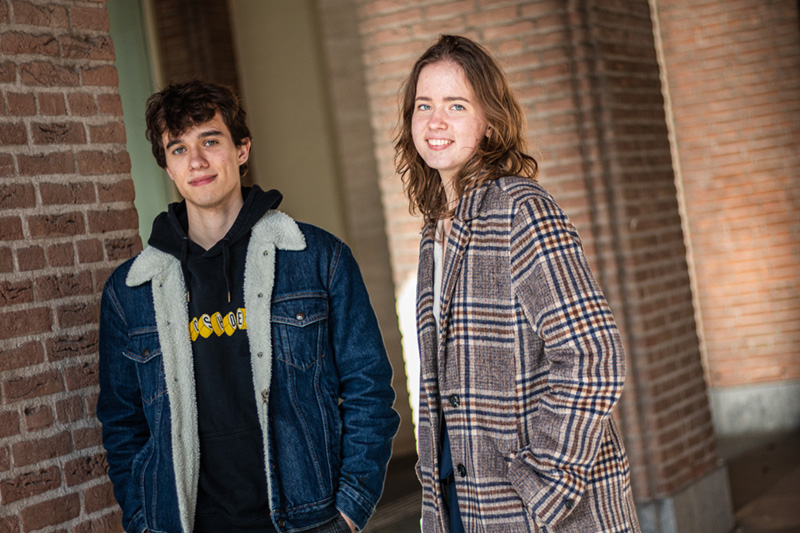400 years of internationalism
‘We don’t have to feel like outsiders’
Whenever he sees the phrases ‘Sorry, no internationals’ or ‘Dutch only’, Michal Lyso (20) knows he doesn’t even have to bother trying to get that room, or that part-time job. ‘Those are only examples, but I can feel it anytime and anywhere’, says the first-year history student from Slovakia. ‘I feel like an outsider here, even though everyone can speak English.’
‘Exactly! Whenever I interact with society, that feeling crops up’, says Anna Bezpala (18) from Ukraine, a second-year communications student at Hanze University of Applied Sciences. ‘I wanted to join a student association with a lot of Dutch members, but I didn’t resonate with them. There are cultural differences, I can understand that. But I still feel like I’m on the outside of society.’
The two students chose to study abroad, ‘but we didn’t choose to be outsiders’, says Michal. It made them wonder: how long have internationals been studying in Groningen?
Hundreds of years
‘As it turns out: ever since the UG was founded in 1614’, says Anna. ‘International students were always here, not just in recent years, but for hundreds of years. We were, and still are, always part of the community and society.’
I feel like an outsider here, even though everyone can speak English
To raise awareness of that, they and their Ukrainian friend Darynka Alieieva (19), who studies at Academy Minerva, set up an exhibition at the UG. ‘We want to convey the idea that discrimination against internationals is unnecessary. We want to tell the real story about the history of internationals’, Michal says.
The exhibition consists of seven life-sized portraits of international students from the past – painted by Darynka – at locations across the UG campus. Since Hanze UAS was only founded in 1986, they focused on the history of the UG.
As a history student, Michal wanted to know whether the antagonism between internationals and Dutch existed in the past as well. ‘Nowadays, there are more and more internationals coming to Groningen, while society wants to be more Dutch and less international’, he says.
Enrollment records
To find their subjects, they researched the Album studiosorum Academiae Groninganae, which records enrolled students from 1614 to 1915. ‘But that was just a starting point’, says Michal, ‘because it only mentioned their personal data: their name, where they’re from, what they studied. We need more. We needed to know their life story: why they came to Groningen, what they did before and after that.’
We needed to know their life story
What made it even more challenging is that the book is written in Latin – even international students’ names were Latinised – and didn’t distinguish between international or Dutch students. Cities or regions of origin were mentioned, but not countries. ‘We tried to Google a few students’ names in the beginning, but it’s information from hundreds of years ago, so that wasn’t helpful’, says Michal.
There was only one way to find out who was an international: review all names and determine where they are from. ‘It’s three hundred pages of lists, so I didn’t really read everyone’s name. I read their notes’, Michal says. The first international he came across was Adam Pisecky. ‘I saw he was from Bohemia, so I knew he was foreign.’
Illustrations
It became easier once they had the students’ names, nationality, the year they enrolled and their study programme. ‘We used another book, The University of Groningen in the World by Klaas van Berkel and Guus Termeer, to get background information on the different eras and find other potential sources’, says Michal.

The final step was making the illustrations. All of them were first painted on paper and then digitised. ‘I did it like that on purpose, because painting on paper is the way people did it hundreds of years ago. I wanted to highlight the significance of history’, says Darynka.
For historically correct depictions, they had to find out the colour and style of clothes of specific eras. ‘Usually, people wore very similar clothes, especially at the universities and in the Senate’, explains Michal. ‘But sometimes we didn’t know what their faces looked like, so I needed to use my imagination’, adds Darynka.
Distant
They spent six months on the project and discovered a few interesting things during that time. The current system of enrollment, for example, hasn’t been in place for that long. ‘Apprenticeship was common from the seventeen until the nineteenth century’, says Michal: students’ families would contact a professor they knew and ask if their son could enrol with them.
They consciously tried to attract internationals
They also found out why the UG has always been an international place: because Groningen was so distant from the parts of the Netherlands where the majority of the population lived. ‘So they consciously tried to attract internationals; for instance, having German students at the UG is a tradition, because Groningen is close to Germany’, says Michal.
Anna sees herself in the internationals of the past: speaking a different language, encountering cultural differences. And their long history at the UG has made her look differently at her experience. ‘We don’t have to feel like outsiders’, she says. ‘We have as much of a right to feel that we belong here as Dutch people.’
The portraits are exhibited across the UG campus until June 2. For locations, see the exhibit website.